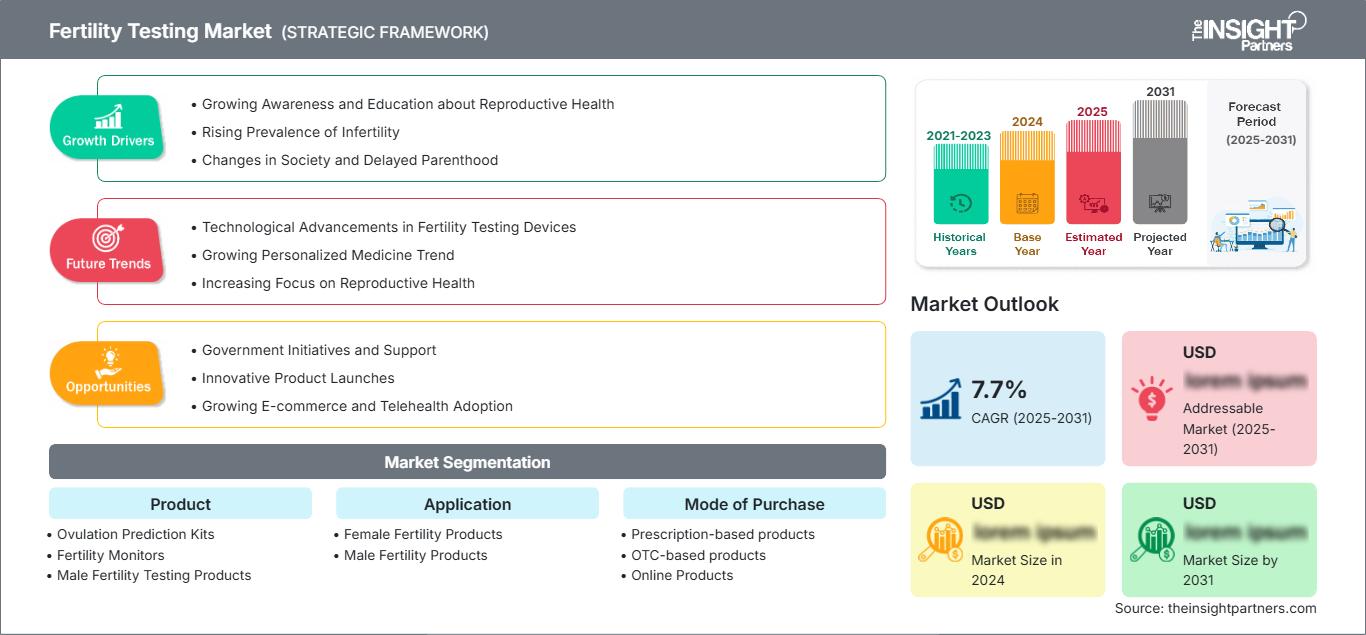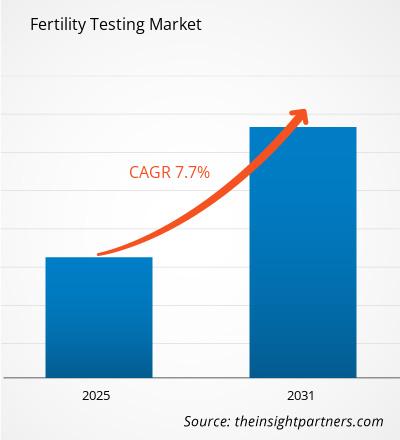Si prevede che il mercato dei test di fertilità raggiungerà i 2,39 miliardi di dollari entro il 2031. Si prevede che il mercato registrerà un CAGR del 7,7% nel periodo 2025-2031.
Il rapporto è segmentato per prodotto (kit per la previsione dell'ovulazione, monitor della fertilità, prodotti per test di fertilità maschile); applicazione (prodotti per la fertilità femminile, prodotti per la fertilità maschile); modalità di acquisto (prodotti con prescrizione medica, prodotti da banco, prodotti online); utente finale (strutture di assistenza domiciliare, ospedali e cliniche per la fertilità, altri). L'analisi globale è ulteriormente suddivisa a livello regionale e per i principali paesi. Il rapporto offre il valore in dollari per l'analisi e i segmenti sopra indicati.
Scopo del rapporto
Il rapporto Fertility Testing Market di The Insight Partners mira a descrivere il panorama attuale e la crescita futura, i principali fattori trainanti, le sfide e le opportunità. Ciò fornirà spunti a vari stakeholder aziendali, come:
- Fornitori/produttori di tecnologia: per comprendere le dinamiche di mercato in evoluzione e conoscere le potenziali opportunità di crescita, consentendo loro di prendere decisioni strategiche informate.
- Investitori: per condurre un'analisi completa delle tendenze in merito al tasso di crescita del mercato, alle proiezioni finanziarie del mercato e alle opportunità esistenti lungo la catena del valore.
- Organismi di regolamentazione: per regolamentare le politiche e le attività di controllo nel mercato con l'obiettivo di ridurre al minimo gli abusi, preservare la fiducia degli investitori e sostenere l'integrità e la stabilità del mercato.
Segmentazione del mercato dei test di fertilità
- Kit per la previsione dell'ovulazione
- Monitor della fertilità
- Prodotti per i test di fertilità maschile
Applicazione
- Prodotti per la fertilità femminile
- Prodotti per la fertilità maschile
Modalità di acquisto
- Prodotti su prescrizione
- Prodotti da banco
- Prodotti online
Utente finale
- Ambienti di assistenza domiciliare
- Ospedali e cliniche per la fertilità
- Altri
Potrai personalizzare gratuitamente qualsiasi rapporto, comprese parti di questo rapporto, o analisi a livello di paese, pacchetto dati Excel, oltre a usufruire di grandi offerte e sconti per start-up e università
Mercato dei test di fertilità: Approfondimenti strategici

- Ottieni le principali tendenze chiave del mercato di questo rapporto.Questo campione GRATUITO includerà l'analisi dei dati, che vanno dalle tendenze di mercato alle stime e alle previsioni.
Fattori di crescita del mercato dei test di fertilità
- Crescente consapevolezza e istruzione sulla salute riproduttiva: c'è una crescente consapevolezza tra la popolazione riguardo ai problemi di salute femminile, tra cui la salute riproduttiva, la menopausa e le condizioni croniche. Questa maggiore consapevolezza stimola la domanda di dispositivi sanitari specializzati per garantire la gestione e il trattamento efficaci delle patologie femminili.
- Crescente prevalenza di infertilità: il tasso di infertilità è in aumento sia negli uomini che nelle donne in tutto il mondo. Con 1 persona su 6 in tutto il mondo che segnala infertilità, la domanda di test di fertilità sta aumentando. Inoltre, la crescente incidenza e prevalenza di condizioni come il cancro al seno, la sindrome dell'ovaio policistico (PCOS) e l'endometriosi stanno contribuendo alla necessità di test precoci.
- Cambiamenti nella società e genitorialità ritardata: i cambiamenti nelle norme sociali, con molte persone che decidono di ritardare la genitorialità per una serie di motivi, contribuiscono anche all'aumento del rischio di insorgenza di problemi di fertilità. La genitorialità ritardata contribuisce a una crescente domanda di test di fertilità, poiché le persone desiderano comprendere la propria salute riproduttiva in relazione alle proprie scelte di vita.
Tendenze future del mercato dei test di fertilità
- Progressi tecnologici nei dispositivi per i test di fertilità: le innovazioni nella tecnologia medica, come i kit monouso per i test di fertilità, i dispositivi di monitoraggio della fertilità a distanza e le soluzioni di telemedicina, stanno rendendo più facile per le donne gestire efficacemente la propria salute. Questi progressi migliorano anche i risultati per i pazienti e aumentano il coinvolgimento degli utenti. I progressi nella tecnologia dei test di fertilità hanno portato allo sviluppo di dispositivi che monitorano vari parametri di salute, come i cicli di ovulazione nelle donne e i test di screening domiciliari negli uomini.
- Crescente tendenza alla medicina personalizzata: l'ascesa della medicina personalizzata, che progetta kit di test in base alle caratteristiche individuali, sta influenzando lo sviluppo di dispositivi che forniscono un monitoraggio della salute personalizzato e opzioni di screening domiciliari per donne e uomini. Inoltre, le applicazioni progettate specificamente per le donne possono monitorare i sintomi, gestire i farmaci e fornire consigli sanitari personalizzati, aumentando così la domanda di dispositivi per i test di fertilità.
- Crescente attenzione alla salute riproduttiva: la crescente consapevolezza sulla salute riproduttiva ha portato a un aumento dei dispositivi che aiutano a monitorare la fertilità, a prevedere l'ovulazione e a gestire la salute riproduttiva in generale. Inoltre, si prevede che le innovazioni volte a monitorare la salute della gravidanza, come i monitor fetali e i dispositivi connessi, acquisiranno popolarità nei prossimi anni.
Opportunità di mercato per i test di fertilità
- Iniziative e supporto governativi: molti governi stanno implementando iniziative incentrate sul miglioramento della salute delle donne, inclusi finanziamenti per la ricerca e incentivi per le aziende che sviluppano dispositivi sanitari innovativi pensati per le donne. Inoltre, la crescente consapevolezza dei problemi di salute femminile ha portato a maggiori investimenti, sia da parte del settore privato che di quello pubblico, per sviluppare dispositivi e soluzioni sanitarie innovative.
- Lancio di prodotti innovativi: la continua introduzione di nuovi prodotti, tra cui monitor indossabili per la salute, tracker per la fertilità e dispositivi per test domiciliari, favorisce la crescita del mercato e soddisfa esigenze diverse. Inoltre, i produttori collaborano sempre più con operatori sanitari e aziende tecnologiche per ampliare l'offerta di prodotti e raggiungere mercati più ampi.
- Crescente adozione di e-commerce e telemedicina: l'ascesa dell'e-commerce e dei servizi di telemedicina ha reso più facile per le donne accedere a dispositivi e consulenze sanitarie, ampliando così la portata del mercato. Inoltre, il ruolo dei social media nell'educare e responsabilizzare le donne sui problemi di salute gioca un ruolo fondamentale nel guidare la domanda di dispositivi per la salute femminile.
Mercato dei test di fertilità
Le tendenze regionali e i fattori che influenzano il mercato dei test di fertilità durante il periodo di previsione sono stati ampiamente spiegati dagli analisti di The Insight Partners. Questa sezione illustra anche i segmenti e la geografia del mercato della gestione delle malattie del ritmo cardiaco in Nord America, Europa, Asia-Pacifico, Medio Oriente e Africa, America meridionale e centrale.
Ambito del rapporto di mercato sui test di fertilità
| Attributo del rapporto | Dettagli |
|---|---|
| Dimensioni del mercato in 2024 | US$ XX Billion |
| Dimensioni del mercato per 2031 | US$ 2.39 Billion |
| CAGR globale (2025 - 2031) | 7.7% |
| Dati storici | 2021-2023 |
| Periodo di previsione | 2025-2031 |
| Segmenti coperti |
By Prodotto
|
| Regioni e paesi coperti | Nord America
|
| Leader di mercato e profili aziendali chiave |
|
Densità degli operatori del mercato dei test di fertilità: comprendere il suo impatto sulle dinamiche aziendali
Il mercato dei test di fertilità è in rapida crescita, trainato dalla crescente domanda degli utenti finali, dovuta a fattori quali l'evoluzione delle preferenze dei consumatori, i progressi tecnologici e una maggiore consapevolezza dei benefici del prodotto. Con l'aumento della domanda, le aziende stanno ampliando la propria offerta, innovando per soddisfare le esigenze dei consumatori e sfruttando le tendenze emergenti, alimentando ulteriormente la crescita del mercato.

- Ottieni il Mercato dei test di fertilità Panoramica dei principali attori chiave
Punti di forza
- Copertura completa: il rapporto analizza in modo esaustivo prodotti, servizi, tipologie e utenti finali del mercato dei test di fertilità, fornendo un panorama olistico.
- Analisi degli esperti: il rapporto è redatto sulla base della conoscenza approfondita di esperti e analisti del settore.
- Informazioni aggiornate: il rapporto garantisce la pertinenza aziendale grazie alla copertura di informazioni e tendenze dei dati recenti.
- Opzioni di personalizzazione: questo rapporto può essere personalizzato per soddisfare le esigenze specifiche del cliente e adattarsi in modo appropriato alle strategie aziendali.
Il rapporto di ricerca sul mercato dei test di fertilità può quindi aiutare a guidare il percorso di decodificazione e comprensione dello scenario del settore e delle prospettive di crescita. Sebbene possano esserci alcune preoccupazioni valide, i vantaggi complessivi di questo rapporto tendono a superare gli svantaggi.
- Analisi storica (2 anni), anno base, previsione (7 anni) con CAGR
- Analisi PEST e SWOT
- Valore/volume delle dimensioni del mercato - Globale, Regionale, Nazionale
- Industria e panorama competitivo
- Set di dati Excel
Report recenti
Rapporti correlati
Testimonianze
Motivo dell'acquisto
- Processo decisionale informato
- Comprensione delle dinamiche di mercato
- Analisi competitiva
- Analisi dei clienti
- Previsioni di mercato
- Mitigazione del rischio
- Pianificazione strategica
- Giustificazione degli investimenti
- Identificazione dei mercati emergenti
- Miglioramento delle strategie di marketing
- Aumento dell'efficienza operativa
- Allineamento alle tendenze normative




















 Ottieni un campione gratuito per - Mercato dei test di fertilità
Ottieni un campione gratuito per - Mercato dei test di fertilità